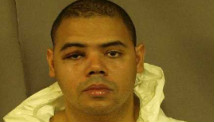STORY HIGHLIGHTS
- NEW: With snow coming, authorities continue to hunt for the suspect near Big Bear Lake
- Police believe former cop Christopher Jordan Dorner shot three officers, killing one
- This was days after he allegedly killed two people, one a retired LAPD officer's daughter
- In an 11-page manifesto, Dorner promises "war" on police and their families
Los Angeles (CNN) -- A former Los Angeles cop with military training vowed war against other men in blue Thursday, leaving one officer dead days after he allegedly killed two other people to begin a wave of retribution for being fired, police said.
The focus of the intensive, expansive manhunt is Christopher Jordan Dorner, a 270-pound former Navy lieutenant who has professed his venom against LAPD officers he claimed ruined his life by forcing him out of his dream job.
Dorner blames one retired officer for bungling his appeal to get his job back in an 11-page manifesto, in which he also complained of mistreatment by the LAPD. In that letter -- provided to CNN by an LAPD source -- he vowed to violently target police officers and their families, whoever and wherever they are.
"I will bring unconventional and asymmetrical warfare to those in LAPD uniform whether on or off duty," Dorner wrote.
"I never had the opportunity to have a family of my own, I'm terminating yours."
Authorities believe he followed through on his threats early Thursday by shooting a Riverside, California, police officer and two others. A day earlier, Irvine police named Dorner a suspect in the double slayings Sunday of a woman -- identified by Los Angeles police as the daughter of a retired LAPD officer -- and her fiance.
"My opinion of the suspect is unprintable," said Riverside police Chief Sergio Diaz, hours after one of his officers was killed. "The manifesto, I think, speaks for itself (as) evidence of a depraved and abandoned mind and heart."
The violence, as well as Dorner's background as a police officer and military trained marksman, left police on edge around Southern California.
In Torrance, LAPD officers guarding one of Dorner's alleged targets mistakenly opened fire on a blue pickup truck that resembled one Dorner was thought to be driving, said Los Angeles police Chief Charlie Beck.
The gunfire left two people wounded, Beck said. Torrance police also fired on another blue pickup, but no one was injured in that incident, according to a senior law enforcement source.
In downtown Los Angeles, police wearing body armor patrolled outside their own iconic headquarters.
Police have good reason to be fearful, the chief said.
"Of course, he knows what he's doing. We trained him," Beck said. "He was also a member of the armed forces. It is extremely worrisome and scary, especially to the officers involved."
The manhunt for Dorner spanned hundreds of miles and numerous counties. By Thursday afternoon, it was largely centered around Big Bear Lake -- about 100 miles east of Los Angeles -- where authorities found the truck the suspect allegedly used in the Riverside shooting.
KTLA: Manhunt for former cop after officers shot
Police confirmed that the vehicle, which was burnt out when it was found, belonged to Dorner by its vehicle identification number, San Bernardino County Sheriff John McMahon said.
This discovery spurred more officers to converge on the area to conduct beefed up patrols, staff checkpoints and go to every residence in the mountain community. McMahon acknowledged the fire may have been set as a diversionary tactic, though law enforcement isn't taking any chances. Early Thursday evening, he said that aerial and K9 searches on the ground will "continue as long as we can" -- though snow is coming -- and urged locals to be on alert.
"He could be anywhere at this point, and that's why we're searching door to door," the sheriff said.
1 cop dies in 'cowardly ambush'
It all started Sunday when Dorner allegedly killed two people in Irvine, according to police.
Police identified the victims as Monica Quan and her fiance Keith Lawrence.
Quan, 27, was the daughter of retired Los Angeles police Officer Randal Quan, LAPD Officer Tenesha Dobine told CNN. In his manifesto, Dorner said Quan handled his appeal.
On Tuesday, Dorner checked into the Navy Gateway Inns and Suites on San Diego's large naval base, Cmdr. Brad Fagan said.
Dorner likely had access to the hotel because he'd been honorably discharged from the Navy Reserve, said the Navy spokesman. Having retired February 1 as a lieutenant, Dorner worked with mobile inshore undersea warfare units and provided security on oil platforms in Iraq, according to Pentagon records. He was rated as a rifle marksman and pistol expert.
"He did not physically check out" Wednesday as expected, Fagan told reporters.
Police in San Diego say a man who could have been Dorner tried to hijack a boat there on Wednesday. Someone later found a wallet containing Dorner's identification and an LAPD detective's badge near the San Diego airport, according to police. It was unclear whether the badge was legitimate.
Timeline in manhunt for former L.A. cop
By about 1 a.m. Thursday, the scene had shifted about 100 miles north to Corona, California.
There, a pair of LAPD officers on a protection detail were flagged down by a citizen who reported seeing the suspect's vehicle, LAPD Deputy Chief Jose Perez said.
The officers chased the vehicle and caught up to it on an Interstate 15 off-ramp.
"The officers were fired upon with a shoulder weapon," Perez said, with one of them suffering a "graze wound" to his head. The police returned fire, while the suspect set off once again.
About 20 minutes later, two police officers were in their car at a stop light in Riverside when Dorner allegedly pulled up beside them.
That driver unleashed "multiple rounds" from a rifle at the officers, riddling the cop car with bullets and leaving a 34-year-old officer, who had been on the Riverside force for 11 years, dead, according to Diaz. The other officer, 27, was "seriously wounded but we expect a full recovery," the Riverside police chief said.
KCBS: Riverside officer fatally shot
It was "a cowardly ambush," said Diaz, claiming Dorner has "no connection" to his city.
A good Samaritan picked up one of their police radios and called dispatchers to send help, Riverside police said.
Suspect calls attacks 'a necessary evil'
In addition to posting his manifesto online, Dorner reached out directly to CNN, mailing a parcel to AC360 anchor Anderson Cooper's office at CNN in New York.
The package arrived on February 1 and was opened by Cooper's assistant. Inside was a hand-labeled DVD, accompanied by a yellow Post-it note reading, in part, "I never lied" -- apparently in reference to his 2008 dismissal from the LAPD.
The package also contained a coin wrapped in duct tape. The tape bears the hand-written inscription: "Thanks, but no thanks, Will Bratton." It also had letters that may be read as "IMOA", which could be a commonly used Internet abbreviation for "Imagine a More Open America," or possibly "1 MOA," which means one minute of angle, perhaps implying Dorner was notably accurate with a firearm.
The coin is a souvenir medallion from former LAPD Chief William Bratton, of a type often given out as keepsakes. This one, though, was shot through with bullet holes: three bullet holes to the center and another shot nicked off the top.
The editorial staff of AC360 and CNN management were made aware of the package Thursday. Upon learning of its existence, they alerted Bratton and law enforcement.
Bratton headed the LAPD at the time Dorner was dismissed.
The dispute centers on a 2007 incident in San Pedro involving a man's arrest at a DoubleTree hotel. Two weeks later, Dorner accused his training officer of kicking the man after he'd given up.
The investigators' report said "the delay in reporting the alleged misconduct coupled with the witness' statements irreparably destroy Dorner's credibility." The report cited contradictory accounts from the arrested man and his father and denials by the accused officer and three hotel employees that the arrested man had been kicked. Dorner claims he was wrongly ousted for blowing the whistle on what he insists was police abuse.
Suspect's grudge dates back to 2007 complaint
Dorner challenged his firing for years, losing at every turn. First, the police department's Board of Rights rejected his appeal. Then, in October 2011, a judge ruled against his appeal, according to court records.
Beck, the Los Angeles police chief, said Thursday that Dorner's case had been "thoroughly reviewed" and said the department would not apologize to Dorner or clear his name.
But as his manifesto shows, Dorner is showing no sign of relenting.
He complained he had been railroaded out of the department after reporting police brutality by another officer. Dorner also complained of a continuing culture of racism and brutality in the LAPD.
Attacks on other police officers and their families, he said, are "a necessary evil that I do not enjoy but must partake and complete for substantial change to occur within the LAPD and reclaim my name."
"Look your wives/husbands and surviving children directly in the face and tell them the truth as to why your children are dead," Dorner wrote.
Such a chilling warning prompted Los Angeles police to set up 40 protective details in an effort to safeguard people listed in Dorner's letter, Beck said.
The chief acknowledged that this effort was taxing the department, which has been placed under tactical alert, meaning all officers must stay on duty.
"It's extremely, extremely manpower intensive," Beck said. "But the safety of my employees, people that come on the job to protect the lives of strangers, is extremely important to me. And I will expend whatever resource is necessary."
KABC: Former cop shoots three officers
CNN's AnneClaire Stapleton, Sara Weisfeldt, Barbara Starr, Pete Janos, Mallory Simon and Deanna Hackney contributed to this report.















